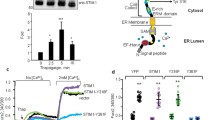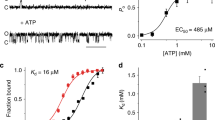Abstract
Bestrophins form Ca2+-activated Cl− channels and regulate intracellular Ca2+ signaling. We demonstrate that bestrophin 1 is localized in the endoplasmic reticulum (ER), where it interacts with stromal interacting molecule 1, the ER-Ca2+ sensor. Intracellular Ca2+ transients elicited by stimulation of purinergic P2Y2 receptors in HEK293 cells were augmented by hBest1. The p21-activated protein kinase Pak2 was found to phosphorylate hBest1, thereby enhancing Ca2+ signaling and activation of Ca2+-dependent Cl− (TMEM16A) and K+ (SK4) channels. Lack of bestrophin 1 expression in respiratory epithelial cells of mBest1 knockout mice caused expansion of ER cisterns and induced Ca2+ deposits. hBest1 is, therefore, important for Ca2+ handling of the ER store and may resemble the long-suspected counterion channel to balance transient membrane potentials occurring through inositol triphosphate (IP3)-induced Ca2+ release and store refill. Thus, bestrophin 1 regulates compartmentalized Ca2+ signaling that plays an essential role in Best macular dystrophy, inflammatory diseases such as cystic fibrosis, as well as proliferation.








Similar content being viewed by others
Abbreviations
- hBest1:
-
human bestrophin 1
- CaCC:
-
Ca2+-activated Cl− channels
- SK4:
-
small conductance calcium-activated potassium channel type 4
- TMEM16A:
-
transmembrane protein 16A
- ANO1:
-
anoctamin 1
- Pak2:
-
p21-activated protein kinase
- ER:
-
endoplasmic reticulum
- SERCA:
-
sarcoendoplasmic reticulum calcium ATPase
- Stim1:
-
stromal interacting molecule 1
- DIDS:
-
4,4′-diisothio-cyanostilbene-2,2′-disulfonic acid
References
AlDehni F, Spitzner M, Martins JR, Barro Soria R, Schreiber R, Kunzelmann K (2009) Role of bestrophin for proliferation and in epithelial to mesenchymal transition. J Am Soc Nephrol 20:1556–1564
Almaca J, Tian Y, AlDehni F, Ousingsawat J, Kongsuphol P, Rock JR, Harfe BD, Schreiber M, Kunzelmann K (2009) TMEM16 proteins produce volume regulated chloride currents that are reduced in mice lacking TMEM16A. J Biol Chem. doi:10.1074/jbc.M109.010074
Bachhuber T, König J, Voelcker T, Mürle B, Schreiber R, Kunzelmann K (2005) Chloride interference with the epithelial Na+ channel ENaC. J Biol Chem 280:31587–31594
Barro Soria R, Schreiber R, Kunzelmann K (2008) Bestrophin 1 and 2 are components of the Ca2+ activated Cl− conductance in mouse airways. Biochim Biophys Acta 1783:1993–2000
Barro Soria R, Spitzner M, Schreiber R, Kunzelmann K (2006) Bestrophin 1 enables Ca2+ activated Cl− conductance in epithelia. J Biol Chem 281:17460–17467
Begault B, Anagnostopoulos T, Edelman A (1993) ATP-regulated chloride conductance in endoplasmic reticulum (ER)-enriched pig pancreas microsomes. Biochim Biophys Acta 1152:319–327
Berridge MJ (2002) The endoplasmic reticulum: a multifunctional signaling organelle. Cell Calcium 32:235–249
Berridge MJ, Irvine RF (1989) Inositol phosphates and cell signalling. Nature 341:197–205
Boudes M, Sar C, Menigoz A, Hilaire C, Pequignot MO, Kozlenkov A, Marmorstein AD, Carroll P, Valmier J, Scamps F (2009) Best1 is a gene regulated by nerve injury and required for Ca2+-activated Cl− current expression in axotomized sensory neurons. J Neurosci 29:10063–10071
Brandman O, Liou J, Park WS, Meyer T (2007) STIM2 is a feedback regulator that stabilizes basal cytosolic and endoplasmic reticulum Ca2+ levels. Cell 131:1327–1339
Caputo A, Caci E, Ferrera L, Pedemonte N, Barsanti C, Sondo E, Pfeffer U, Ravazzolo R, Zegarra-Moran O, Galietta LJ (2008) TMEM16A, a membrane protein associated with calcium-dependent chloride channel activity. Science 322:590–594
Chu PC, Wu J, Liao XC, Pardo J, Zhao H, Li C, Mendenhall MK, Pali E, Shen M, Yu S, Taylor VC, Aversa G, Molineaux S, Payan DG, Masuda ES (2004) A novel role for p21-activated protein kinase 2 in T cell activation. J Immunol 172:7324–7334
Coonan JR, Lamb GD (1998) Effect of chloride on Ca2+ release from the sarcoplasmic reticulum of mechanically skinned skeletal muscle fibres. Pflugers Arch 435:720–730
Fischer KG, Leipziger J, Rubini-Illes P, Nitschke R, Greger R (1996) Attenuation of stimulated Ca2+ influx in colonic epithelial (HT29) cells by cAMP. Pflugers Arch 432:735–740
Hartzell HC (2008) Molecular physiology of bestrophins: multifunctional membrane proteins linked to best disease and other retinopathies. Physiol Rev 88:639–672
Hirota S, Helli P, Janssen LJ (2007) Ionic mechanisms and Ca2+ handling in airway smooth muscle. Eur Respir J 30:114–133
Hirota S, Trimble N, Pertens E, Janssen LJ (2006) Intracellular Cl− fluxes play a novel role in Ca2+ handling in airway smooth muscle. Am J Physiol Lung Cell Mol Physiol 290:L1146–L1153
Huang Z, Ling J, Traugh JA (2003) Localization of p21-activated protein kinase gamma-PAK/Pak2 in the endoplasmic reticulum is required for induction of cytostasis. J Biol Chem 278:13101–13109
Janssen LJ (2002) Ionic mechanisms and Ca2+ regulation in airway smooth muscle contraction: do the data contradict dogma? Am J Physiol Lung Cell Mol Physiol 282:L1161–L1178
Janssen LJ (2009) Asthma therapy: how far have we come, why did we fail and where should we go next? Eur Respir J 33:11–20
Joiner WJ, Wang LY, Tang MD, Kaczmarek LK (1997) hSK4, a member of a novel subfamily of calcium-activated potassium channels. Proc Natl Acad Sci USA 94:11013–11018
Kourie JI (1997) ATP-sensitive voltage- and calcium-dependent chloride channels in sarcoplasmic reticulum vesicles from rabbit skeletal muscle. J Membr Biol 157:39–51
Kunzelmann K, Milenkovic VM, Spitzner M, Barro Soria R, Schreiber R (2007) Calcium dependent chloride conductance in epithelia: Is there a contribution by Bestrophin? Pflugers Arch 454:879–889
Marmorstein AD, Marmorstein LY, Rayborn M, Wang X, Hollyfield JG, Petrukhin K (2000) Bestrophin, the product of the Best vitelliform macular dystrophy gene (VMD2), localizes to the basolateral plasma membrane of the retinal pigment epithelium. Proc Natl Acad Sci USA 97:12758–12763
Marmorstein LY, McLaughlin PJ, Stanton JB, Yan L, Crabb JW, Marmorstein AD (2002) Bestrophin interacts physically and functionally with protein phosphatase 2A. J Biol Chem 277(34):30591–30597
Milenkovic VM, Schreiber R, Barro Soria R, AlDehni F, Kunzelmann K (2009) Functional assembly and purinergic activation of bestrophins. Pflugers Arch 458:431–441
Nakai J, Ohkura M, Imoto K (2001) A high signal-to-noise Ca2+ probe composed of a single green fluorescent protein. Nat Biotechnol 19:137–141
O’Driscoll KE, Leblanc N, Hatton WJ, Britton FC (2009) Functional properties of murine bestrophin 1 channel. Biochem Biophys Res Commun 384:476–481
Park KS, Jeon SH, Oh JW, Choi KY (2004) p21Cip/WAF1 activation is an important factor for the ERK pathway dependent anti-proliferation of colorectal cancer cells. Exp Mol Med 36:557–562
Qu Z, Fischmeister R, Hartzell HC (2004) Mouse bestrophin-2 is a bona fide Cl− channel: identification of a residue important in anion binding and conduction. J Gen Physiol 123:327–340
Qu Z, Wei RW, Mann W, Hartzell HC (2003) Two bestrophins cloned from Xenopus laevis oocytes express Ca-activated Cl currents. J Biol Chem 278:49563–49572
Ribeiro CM, Paradiso AM, Carew MA, Shears SB, Boucher RC (2005) Cystic fibrosis airway epithelial Ca2+ i signaling. The mechanism for the larger agonist-mediated Ca2+ i signals in human cystic fibrosis airway epithelia. J Biol Chem 280:10202–10209
Rosenthal R, Bakall B, Kinnick T, Peachey N, Wimmers S, Wadelius C, Marmorstein AD, Strauss O (2006) Expression of bestrophin-1, the product of the VMD2 gene, modulates voltage-dependent Ca2+ channels in retinal pigment epithelial cells. FASEB J 20:178–180
Schreiber R (2005) Ca2+ signaling, intracellular pH and cell volume in cell proliferation. J Membr Biol 205:129–137
Schreiber R, Castrop H, Kunzelmann K (2008) Allergen induced airway hyperresponsiveness is absent in ecto-5′-nucleotidase (CD73) deficient mice. Pflugers Arch 457:431–440
Schroeder BC, Cheng T, Jan YN, Jan LY (2008) Expression cloning of TMEM16A as a calcium-activated chloride channel subunit. Cell 134:1019–1029
Spitzner M, Martins JR, Barro Soria R, Ousingsawat J, Scheidt K, Schreiber R, Kunzelmann K (2008) Eag1 and bestrophin 1 are upregulated in fast growing colonic cancer cells. J Biol Chem 283:7421–7428
Stanton JB, Goldberg AF, Hoppe G, Marmorstein LY, Marmorstein AD (2006) Hydrodynamic properties of porcine bestrophin-1 in Triton X-100. Biochim Biophys Acta 1758:241–247
Strauss O (2005) The retinal pigment epithelium in visual function. Physiol Rev 85:845–881
Sun H, Tsunenari T, Yau KW, Nathans J (2001) The vitelliform macular dystrophy protein defines a new family of chloride channels. Proc Natl Acad Sci USA 99:4008–4013
Takeshima H, Komazaki S, Hirose K, Nishi M, Noda T, Iino M (1998) Embryonic lethality and abnormal cardiac myocytes in mice lacking ryanodine receptor type 2. EMBO J 17:3309–3316
Tsunenari T, Sun H, Williams J, Cahill H, Smallwood P, Yau KW, Nathans J (2003) Structure–function analysis of the bestrophin family of anion channels. J Biol Chem 278:41114–41125
Wilkes MC, Murphy SJ, Garamszegi N, Leof EB (2003) Cell-type-specific activation of PAK2 by transforming growth factor beta independent of Smad2 and Smad3. Mol Cell Biol 23:8878–8889
Yang YD, Cho H, Koo JY, Tak MH, Cho Y, Shim WS, Park SP, Lee J, Lee B, Kim BM, Raouf R, Shin YK, Oh U (2008) TMEM16A confers receptor-activated calcium-dependent chloride conductance. Nature 455:1210–1215
Yazawa M, Ferrante C, Feng J, Mio K, Ogura T, Zhang M, Lin PH, Pan Z, Komazaki S, Kato K, Nishi M, Zhao X, Weisleder N, Sato C, Ma J, Takeshima H (2007) TRIC channels are essential for Ca2+ handling in intracellular stores. Nature 448:78–82
Zhan Q, Ge Q, Ohira T, Van Dyke T, Badwey JA (2003) p21-activated kinase 2 in neutrophils can be regulated by phosphorylation at multiple sites and by a variety of protein phosphatases. J Immunol 171:3785–3793
Zhang SL, Yu Y, Roos J, Kozak JA, Deerinck TJ, Ellisman MH, Stauderman KA, Cahalan MD (2005) STIM1 is a Ca2+ sensor that activates CRAC channels and migrates from the Ca2+ store to the plasma membrane. Nature 437:902–905
Acknowledgments
This study was supported by the grants DFG SFB699 A6/A7, DFG KU 756/8-2, and Else Kröner-Fresenius-Stiftung P36/05//A44/05. We are grateful for the technical expertise of Caio Toledo, Christine Meese, Karin Schadendorf, Helga Schmidt, and Uwe de Vries in performing the ultrastructural analysis. The Ca2+-sensitive GFP protein G-CaMP2 was kindly provided by Dr. J. Nakai, Wako City Saitama, Japan. We gratefully acknowledge the supply of the vmd2−/− mice by MERCK Research Laboratories (770 Sumneytown Pike, West Point, PA, USA).
Author information
Authors and Affiliations
Corresponding author
Additional information
René Barro-Soria and Fadi Aldehni contributed equally to the present study.
Electronic supplementary materials
Below is the link to the electronic supplementary material.
Supplement 1
(PDF 103 kb).
Supplement 2
(PDF 61.3 kb).
Rights and permissions
About this article
Cite this article
Barro-Soria, R., Aldehni, F., Almaça, J. et al. ER-localized bestrophin 1 activates Ca2+-dependent ion channels TMEM16A and SK4 possibly by acting as a counterion channel. Pflugers Arch - Eur J Physiol 459, 485–497 (2010). https://doi.org/10.1007/s00424-009-0745-0
Received:
Revised:
Accepted:
Published:
Issue Date:
DOI: https://doi.org/10.1007/s00424-009-0745-0




